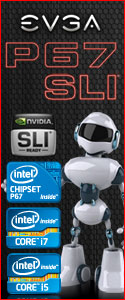Internal Looks
Continuing our tour of the Coolermaster Storm Trooper, or as we in our offices have unofficially dubbed it ‘The Overlord of Evil’ we move on to the internal area of this case. So far we have not had anything to be concerned about. However can the ‘Overlord’ continue its reign of ‘perfect evil’ and seduce us to do its whim? Only a Internal tour and installation will tell.
As usual the side panels are held in place by two black thumbscrews and once taken out the panels come of with a reassuring and meaty ‘thunk’
 |
 |
At last the innards are exposed and we view the motherboard tray itself. The later mentioned looks to be of a high standard and the wire management looks to be 100 percent correct. There is a large management whole placed right after the power supply unit (which is well supported) in order to hide those cables. The best thing is that (Unlike the HAF-X) the eight-pin 12 volt EPS (CPU) connector is in exactly the right place. We did find it a bit puzzling as to why the hole for the CPU connector has no rubber grommet. Surely it would need to be present, even if to give a sense of consistency throughout the rest of the management system?
 |
 |
 |
 |
 |
 |
Next we see what the wire management system looks like from behind.
 |
 |
 |
 |
All the leads go into their logical areas, without stretching and the quality of the rubber grommets themselves are excellent and are hard to remove. Speaking of the latter, there are a great many cases out in the market where the previously mentioned grommets simply fall out of their sockets when subject to the slightest stress; so with this in mind it is great to see that these stay securely in place.
So that’s it for this part of the wire management section, let us now move onto the drive cage assembly.
We think Coolermaster have really been listening to their customers needs and instead of manufacturing the drive bays in a ‘fixed’ position they can now be rotated at 90 degree angles. However, the buck does not stop there. If the consumer so chooses they can even remove the drive cages and the bays that support them. This will ensure there is plenty of room for a large radiator (placed on the bottom panel) in a push-pull configuration.
 |
 |
 |
 |
Radiator installation will be covered later in the review.
Each of the drive cages has a 120mm fan in order to cool any hard drive that may be installed there. Theses drive cages are held in place by two thumbscrews (one at either side) and then the whole assembly simply slides out.
 |
 |
The drives themselves are placed within a caddy and then inserted into the drive cages shown above. However when looking at these, they do not feel as durable as the drive caddies available with the Thermaltake Chaser Mk1, but they do the job and that is what counts.
 |
 |
The actual process of turning the cages 90 degrees will be covered during the water cooling installation section of this review.
Remember earlier we were speaking of the ‘Storm badge’ that clips off the front panel to reveal a box? Well here it is, this contains all the extra screws, mounting bolts and various other devices needed to make installation a little bit easier.
 |
 |
 |
 |














 Posted in
Posted in 





